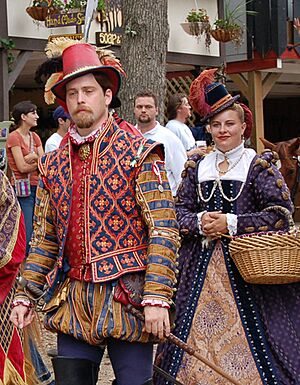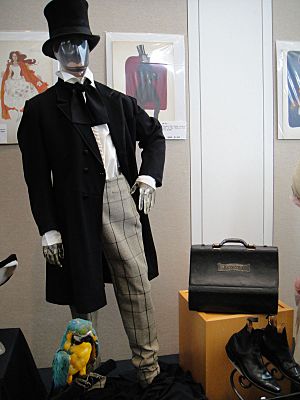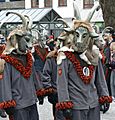Costume facts for kids
A costume is a special outfit that people wear. It can be a type of clothing that shows where someone is from, what time period they lived in, or what job they do. Costumes are also worn to pretend to be a character or a specific type of person. You might see costumes at a fancy dress party, a masquerade, or in a play.
Contents
What is a Costume?
A costume is more than just everyday clothes. It's designed to help tell a story or show something special. For example, a costume can show the style of clothes from a long time ago, like a knight's armor. It can also show the traditional clothes of a certain country or region.
Costumes are also used when people want to dress up as someone else. This could be a superhero, a princess, or a historical figure. They help the person wearing them look and feel like the character they are playing.
National Costumes
Showing Where You're From
National or regional costumes are special clothes that show which country or area someone comes from. Long ago, many people wore these traditional clothes every day.
Today, most people don't wear national costumes for everyday life. Instead, they often wear them for special celebrations, cultural events, or traditional dancing. These costumes are a way to celebrate heritage and show pride in one's background.
Famous Examples
Some well-known national costumes include the kilt, which is worn by people in Scotland. Another famous example is the kimono, a beautiful traditional outfit worn in Japan. These costumes are recognized around the world.
Costumes in Entertainment
Theatrical Costumes
When actors perform in the theatre, they almost always wear costumes. These special clothes help them pretend to be a certain character in the story they are acting out. An actor might wear a costume to look like a king, a beggar, or even an ancient god.
Sometimes, theatrical costumes can be a bit exaggerated or funny. For example, characters like Harlequin and Pantaloon from the old Italian plays called Commedia dell'arte wear very distinctive and playful costumes.
Costumes in Film and TV
You see many different kinds of costumes in movies and on TV shows. Costume designers work hard to create outfits that fit the story, the characters, and the time period. These costumes help make the characters believable and the stories come alive on screen.
Sports Mascots
Another popular place to see costumes is at sporting events. Teams often have mascots who wear big, fun costumes. These mascots help cheer on the team and get the crowd excited. They are a symbol for the team and help fans feel connected.
Costumes for Celebrations

Wearing costumes is a big part of many holidays and festivals. For example, people love to dress up for Mardi Gras and Halloween. Costumes are also sometimes worn for other holidays like Christmas and Easter.
Halloween and Mardi Gras
For Mardi Gras, costumes are often bright and colorful, like jesters or other fantasy characters. Halloween costumes are traditionally spooky, like ghosts, vampires, or other supernatural creatures.
Christmas and Easter
During Christmas, you might see people dressed as Santa Claus in a santa suit with a beard. For Easter, some people dress up as the Easter Bunny in a furry costume. These costumes help bring holiday characters to life.
Other Holidays
Costumes can also be worn for other special days. For instance, on Independence Day in the United States, someone might wear an Uncle Sam costume to celebrate.
Related pages
Images for kids
-
A costume used in yakshagana, a theater art from India
-
A traditional, European-style Santa suit
-
Ibex costumes
-
A U.S. university's cheerleading group at a performance, wearing costume as per their gender.







